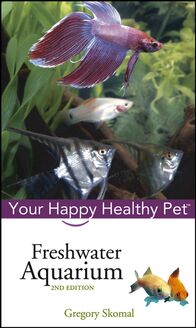The Lizard , livre ebook
73
pages
English
Ebooks
2008
Vous pourrez modifier la taille du texte de cet ouvrage
Obtenez un accès à la bibliothèque pour le consulter en ligne En savoir plus
Découvre YouScribe en t'inscrivant gratuitement
Découvre YouScribe en t'inscrivant gratuitement
73
pages
English
Ebooks
2008
Vous pourrez modifier la taille du texte de cet ouvrage
Obtenez un accès à la bibliothèque pour le consulter en ligne En savoir plus
Publié par
Date de parution
21 avril 2008
Nombre de lectures
0
EAN13
9780470331033
Langue
English
Poids de l'ouvrage
2 Mo
- Feeding
- Grooming
- Housing
- health care
- what to expect from the pet c basic training
As our series expands and focuses on different kinds of pets, the emphasis remains on making the pet a companion. Owners of more unusual pets will particularly appreciate the expert advice in these books because professional care for exotic animals can be hard to come by. As always, the instruction on the books is from experts people who know their pets intimately but always remember what it was like to have one the first time. Happy, Healthy Pet guides are rich with professional quality color photos and are designed to be enjoyable and easy to learn from. Expert herper and author Steve Grenard details care information for a variety of lizards commonly kept as pets, including geckos, anoles, monitors and more.
Publié par
Date de parution
21 avril 2008
Nombre de lectures
0
EAN13
9780470331033
Langue
English
Poids de l'ouvrage
2 Mo
The Lizard
Howell Book House
Howell Book House
A Simon Schuster Macmillan Company
1633 Broadway
New York, NY 10019
Macmillan Publishing books may be purchased for business or sales promotional use. For information please write: Special Markets Department, Macmillan Publishing USA, 1633 Broadway, New York, NY 10019.
Copyright 1998 by Howell Book House
All rights reserved. No part of this book may be reproduced or transmitted in any form or by any means, electronic or mechanical, including photocopying, recording or by any information storage or retrieval system, without permission in writing from the Publisher.
MACMILLAN is a registered trademark of Macmillan, Inc.
Cataloging-in-Publication Data available upon request from the Library of Congress
ISBN 0-87605-429-7
Manufactured in the United States of America
10 9 8 7 6 5 4 3 2
Series Director: Amanda Pisani
Assistant Director: Jennifer Liberts
Book Design: Michele Laseau
Cover Design: Iris Jeromnimon
Illustration: Laura Robbins and Bryan Towse
Photography:
Front cover photo by Bill Love; back cover photo by B. Everett Webb
Joan Balzarini: 22 , 31 , 33 , 52 , 115 , 121
Kevin Grenard: 34 , 70 , 83 , 88 , , 103
J. Harris: 94
Bill Love: i, 5 , 9 , 13 , 17 , 20 , 26 , 37 , 40 , 44 , 45 , 47 , 49 , 51 , 57 , 60 , 61 , 71 , 76 , 78 , 107 , 108 , 114 , 118 , 119 , 122
L. Puente: 11 , 27 , 32 , 38 , 41 , 42 , 62 , 73 , 75 , 105 , 113 , 117
S. Schafer: 7
Al Swanson: 6 , 55 , 86 , 109
B. Everett Webb: 2-3 , 12 , 25 , 28-29 , 30 , 36 , 50 , 58 , 65 , 67 , 80-81 , 82 , 96 , 98 , 100 , 101 Production Team: Stephanie Hammen, Clint Lahnen, Stephanie Mohler, Dennis Sheehan, Terri Sheehan, Chris Van Camp
Contents
part one
Welcome to the World of the Lizard
1 What Is a Lizard?
2 Anatomy and Physiology of Lizards
3 Prehistoric Origins of Lizards
part two
Your Pet Lizard
4 Why a Reptile Pet?
5 Lizard Families
6 Choosing a Pet Lizard
part three
Caring for Your Lizard
7 Housing Your Lizard
8 Feeding Your Lizard
9 Keeping Your Lizard Healthy
part four
Beyond the Basics
10 Lizard Conservation
11 Resources
part one
External Features of the Lizard
chapter 1
What Is a Lizard?
Lizards are reptiles (class Reptilia) that belong to the order Squamata, and the suborders Sauria or Lacertilia. Snakes are also in the order Squamata (suborders Serpentes or Ophidia), as are an odd group of wormlike ringed or annulated reptiles known as worm lizards (suborder Amphisbaenia), and lizardlike reptiles, known as the Tuataras or Sphenodons (suborder Rhynchocephalia) , found only in New Zealand. All the creatures in the order Squamata are called squamates.
Lizard Basics
Modern lizards are neither dinosaurs nor descendants of dinosaurs, even though the word dinosaur translates to terrible lizard. Most lizards have elongated bodies, four legs and scaly skin and do indeed resemble dinosaurs in miniature. However, when you compare the evolution of modern lizards to that of dinosaurs, the differences between them are so great it becomes apparent that lizards are not modern day dinosaurs, in spite of their resemblance.
The majority of lizard species lay hard-shelled eggs on land. Here is a Bearded Dragon hatching.
R EPRODUCTION M ETHODS
The majority of lizards lay hard-shelled eggs on land, although there are some that are viviparous (giving birth to live young incubated internally). One type of Brazilian skink develops its young directly in the oviduct with a placentalike link between mother and embryo, a feature unique among reptiles, although standard in mammals. Some species of lizard are all female and reproduce via a form of fertilization known as parthenogenesis, resulting in so-called Virgin-birth. No males are needed to sustain these lizard groups. However, most lizards reproduce through sexual means via internal fertilization by the male. Lizards may breed yearly, several times yearly or even every other year. Small lizards, such as geckos, may lay only one or two hard-shelled eggs (which look like pebbles); other lizards lay twenty or more eggs and some produce that many young via live birth.
E CTOTHERMIC A NIMALS
Like all other reptiles, fish and amphibians, lizards are considered cold-blooded. The term cold-blooded is actually inaccurate-when these animals are active their blood is anything but cold. A better term is ectothermic, which means they are dependent on the temperature of their environment to warm up or cool down their bodies. Lizards thermoregulate (control their body temperatures) by basking in the sun, burrowing underground or hiding in the shade. In nature, lizards are able to control their body temperatures very precisely by seeking out different environments. In captivity, they must be given the same sorts of options-warm spots and cool spots. In order to eat, digest and metabolize their food, it is essential that they be kept warm. When resting, or if they become overheated, it is essential that they have the option of escaping the heat. This will be discussed in more detail in chapter 7 .
Lizards are an extremely diverse group with over 4,000 different species and subspecies. Pictured here is a Red Flat-tailed Gecko camouflaged against the bark of a tree.
A D IVERSE G ROUP
There are more than 4,000 different species and subspecies of lizards, making them among the most diverse members of the class Reptilia. They range in size from about 1 inch to over 10 feet in length. Several groups have absent or almost absent legs, giving these animals a snakelike appearance, although their heads are still distinctly lizardlike and they re easy to recognize as lizards. There is only one genus with two species that is truly venomous: the Helodermids, including the Gila Monster (Heloderma suspectum) of the southwestern United States and Beaded Lizard (Heloderma horridum) of Mexico. There are no other venomous lizards in existence, although there are some common misconceptions that other species are also venomous. The Komodo Dragon (Varanus komodiensis) of Indonesia and the Bornean Earless Lizard (Lanthanotus borneensis) are often believed to be truly venomous due to the ferocity of their bite and the rapid infection that occurs in the wounds. People bitten by these lizards become seriously ill and may even die within days from sepsis, an infectious complication, which helps to perpetuate the myth that these lizards are venomous. Although their bites are indeed very dangerous, they are not venomous. Fortunately, none of these dangerous lizards show up in the pet trade, and they should be avoided in the unlikely event an opportunity arises to obtain one.
VENOMOUS REPTILES
Unlike many snake species, very few species of lizard are venomous. Those that are venomous are not commercially traded, and you should not worry about bringing a venomous lizard into your home. Nonetheless, you should be wary of being bitten by your lizard-careful handling is the best defense.
C ONSERVATION C ONSIDERATIONS
Like wildlife everywhere, lizards are threatened by habitat destruction, and their numbers are dwindling as a result of this encroachment. To help stem the loss of these fabulous animals, many species and their habitats are protected by law. Most lizards are easy to breed in captivity and ever greater numbers of lizards are supplied as pets through captive breeding programs, which helps to take pressure off wild populations heavily collected for the pet trade. In Central and South America, iguanas were not only captured for the pet trade, but also eaten and their hides used to make a variety of items. Seeing the commercial value in this popular species, government-sponsored iguana farming and ranching operations have been set up to help supply this trade and to prevent removal of free living specimens from the wild.
THREATENED SPECIES
Many lizards qualify as endangered species, although they vary in degree of endangerment. For example, all iguanas are protected under the auspices of the CITES (Convention on the International Trade of Endangered Species). This means that they may be sold in their own countries, but if these species are listed as threatened, exporting them between countries requires extensive permits. This is the reason that many iguanas bought in the United States today are bred here on farms or ranches.
Like the baby turtles of the 1950s and 1960s, now banned because of the their propensity to infect small children with salmonella, baby iguanas have boomed Lizard? in popularity over the past few years and may exceed the number of all other reptiles combined for the prize as the most popular reptile pet. More than one million baby iguanas are imported annually into the United States and hundreds of thousands more are brought in as unhatched fertilized eggs, which are incubated on U.S. soil for the domestic pet trade. (Unfortunately iguanas, as do most herptiles, do carry salmonella, but the threat of this infection is easy to counter with some important but simple precautions presented in chapter 9 .)
Iguanas are the most papular lizard pet. (Green Iguana)
A Word to the Wise
Before anyone considers a Green Iguana or any other lizard pet, he or she has to realize that the means to house, feed and otherwise care for the lizard far exceeds the actual cost of the animal itself. This is true of tropical fish, dogs, cats and, yes, human children! To the $10 a baby iguana costs, add hundreds of dollars a year required to care for it properly. In addition to the few moments it takes for you to fall in love with the iguana at the pet store, you must commit to many hours of caring for your pet. If you are not prepared for these kinds of financial and time commitments, reconsider purchasing a pet.
Although iguanas are the most popular and among the least expensive lizard pets, there are many other interesting and unusual lizards to consider. This book will help you learn ab














